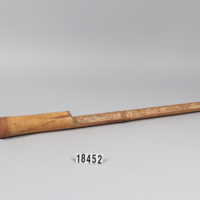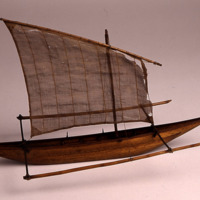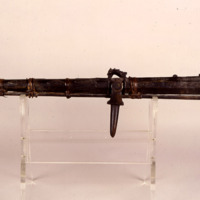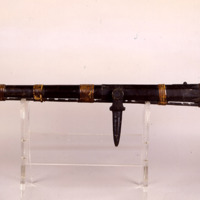Quiver
Text
Made of wood and bejuco. On the upper edge there is a small recess that forms a sort of neck into which the lid would fit. (Currently lost). The rest is smooth cylindrical, the central part is lined with bejuco wound around the vase and woven into two braids lengthwise, one at the front holding a narrow strip of polished wood and another on the back in which a polished wooden handle is attached, in the shape of a fork that It was used to attach the quiver to the belt. The vine is finished off at the bottom with a braided ring. The lid would also be made of cylindrical bamboo and would be attached to the glass with a cord or vine braid. It was used to store the poisoned darts that were shot with a blowgun. The poison normally came from the Sa Ogús tree.
Spanish version:
Fabricado en madera y bejuco. En el borde superior presenta un pequeño rebaje que forma una especie de cuello en el que encajaría la tapa. (Actualmente perdida). El resto es cilíndrico liso, la parte central está forrada con bejuco enrollada alrededor del vaso y tejido formando dos trenzas en sentido longitudinal, una en la parte frontal que sujeta una tira estrecha de madera pulida y otra en la parte posterior en la que se sujeta un asa de madera pulida, en forma de horquilla que servía para sujetar el carcaj al cinturón. El bejuco se remata en la parte inferior con un anillo trenzado.
La tapa sería también de bambú cilíndrica y se uniría al vaso con un cordel o trenza de bejuco.
Servía para guardar los dardos envenenados que se disparaban con cerbatana. El veneno normalmente procedía del árbol Sa Ogús.
Share this



